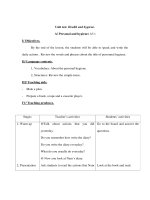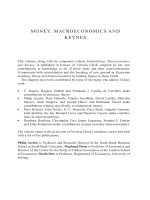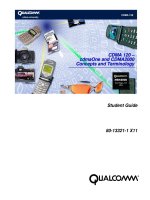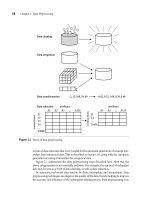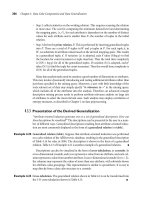Data Mining Concepts and Techniques phần 1 potx
Bạn đang xem bản rút gọn của tài liệu. Xem và tải ngay bản đầy đủ của tài liệu tại đây (1.49 MB, 78 trang )
Data Mining:
Concepts and Techniques
Second Edition
The Morgan Kaufmann Series in Data Management Systems
Series Editor: Jim Gray, Microsoft Research
Data Mining: Concepts and Techniques, Second Edition
Jiawei Han and Micheline Kamber
Querying XML: XQuery, XPath, and SQL/XML in context
Jim Melton and Stephen Buxton
Foundations of Multidimensional and Metric Data Structures
Hanan Samet
Database Modeling and Design: Logical Design, Fourth Edition
Toby J. Teorey, Sam S. Lightstone and Thomas P. Nadeau
Joe Celko’s SQL for Smarties: Advanced SQL Programming, Third Edition
Joe Celko
Moving Objects Databases
Ralf G
uting and Markus Schneider
Joe Celko’s SQL Programming Style
Joe Celko
Data Mining: Practical Machine Learning Tools and Techniques, Second Edition
Ian Witten and Eibe Frank
Fuzzy Modeling and Genetic Algorithms for Data Mining and Exploration
Earl Cox
Data Modeling Essentials, Third Edition
Graeme C. Simsion and Graham C. Witt
Location-Based Services
Jochen Schiller and Agnès Voisard
Database Modeling with Microsft® Visio for Enterprise Architects
Terry Halpin, Ken Evans, Patrick Hallock, Bill Maclean
Designing Data-Intensive Web Applications
Stephano Ceri, Piero Fraternali, Aldo Bongio, Marco Brambilla, Sara Comai, andMaristella Matera
Mining the Web: Discovering Knowledge from Hypertext Data
Soumen Chakrabarti
Advanced SQL:II 1999—Understanding Object-Relational and Other Advanced Features
Jim Melton
Database Tuning: Principles, Experiments, and Troubleshooting Techniques
Dennis Shasha and Philippe Bonnet
SQL:1999—Understanding Relational Language Components
Jim Melton and Alan R. Simon
Information Visualization in Data Mining and Knowledge Discovery
Edited by Usama Fayyad, Georges G. Grinstein, and Andreas Wierse
Transactional Information Systems: Theory, Algorithms, and Practice of Concurrency
Control and Recovery
Gerhard Weikum and Gottfried Vossen
Spatial Databases: With Application to GIS
Philippe Rigaux, Michel Scholl, and Agnes Voisard
Information Modeling and Relational Databases: From Conceptual Analysis to Logical Design
Terry Halpin
Component Database Systems
Edited by Klaus R. Dittrich and Andreas Geppert
Managing Reference Data in Enterprise Databases: Binding Corporate Data to the Wider World
Malcolm Chisholm
Data Mining: Concepts and Techniques
Jiawei Han and Micheline Kamber
Understanding SQL and Java Together: A Guide to SQLJ, JDBC, and Related Technologies
Jim Melton and Andrew Eisenberg
Database: Principles, Programming, and Performance, Second Edition
Patrick and Elizabeth O’Neil
The Object Data Standard: ODMG 3.0
Edited by R. G. G. Cattell and Douglas K. Barry
Data on the Web: From Relations to Semistructured Data and XML
Serge Abiteboul, Peter Buneman, and Dan Suciu
Data Mining: Practical Machine Learning Tools and Techniques with Java Implementations
Ian Witten and Eibe Frank
Joe Celko’s SQL for Smarties: Advanced SQL Programming, Second Edition
Joe Celko
Joe Celko’s Data and Databases: Concepts in Practice
Joe Celko
Developing Time-Oriented Database Applications in SQL
Richard T. Snodgrass
Web Farming for the Data Warehouse
Richard D. Hackathorn
Management of Heterogeneous and Autonomous Database Systems
Edited by Ahmed Elmagarmid, Marek Rusinkiewicz, and Amit Sheth
Object-Relational DBMSs: Tracking the Next Great Wave, Second Edition
Michael Stonebraker and Paul Brown,with Dorothy Moore
A Complete Guide to DB2 Universal Database
Don Chamberlin
Universal Database Management: A Guide to Object/Relational Technology
Cynthia Maro Saracco
Readings in Database Systems, Third Edition
Edited by Michael Stonebraker and Joseph M. Hellerstein
Understanding SQL’s Stored Procedures: A Complete Guide to SQL/PSM
Jim Melton
Principles of Multimedia Database Systems
V. S. Subrahmanian
Principles of Database Query Processing for Advanced Applications
Clement T. Yu and Weiyi Meng
Advanced Database Systems
Carlo Zaniolo, Stefano Ceri, Christos Faloutsos, Richard T. Snodgrass,
V. S. Subrahmanian, and Roberto Zicari
Principles of Transaction Processing
Philip A. Bernstein and Eric Newcomer
Using the New DB2: IBMs Object-Relational Database System
Don Chamberlin
Distributed Algorithms
Nancy A. Lynch
Active Database Systems: Triggers and Rules For Advanced Database Processing
Edited by Jennifer Widom and Stefano Ceri
Migrating Legacy Systems: Gateways, Interfaces, & the Incremental Approach
Michael L. Brodie and Michael Stonebraker
Atomic Transactions
Nancy Lynch, Michael Merritt, William Weihl, and Alan Fekete
Query Processing for Advanced Database Systems
Edited by Johann Christoph Freytag, David Maier, and Gottfried Vossen
Transaction Processing: Concepts and Techniques
Jim Gray and Andreas Reuter
Building an Object-Oriented Database System: The Story of O
2
Edited by François Bancilhon, Claude Delobel, and Paris Kanellakis
Database Transaction Models for Advanced Applications
Edited by Ahmed K. Elmagarmid
A Guide to Developing Client/Server SQL Applications
Setrag Khoshafian, Arvola Chan, Anna Wong, and Harry K. T. Wong
The Benchmark Handbook for Database and Transaction Processing Systems, Second Edition
Edited by Jim Gray
Camelot and Avalon: A Distributed Transaction Facility
Edited by Jeffrey L. Eppinger, Lily B. Mummert, and Alfred Z. Spector
Readings in Object-Oriented Database Systems
Edited by Stanley B. Zdonik and David Maier
Data Mining:
Concepts and Techniques
Second Edition
Jiawei Han
University of Illinois at Urbana-Champaign
Micheline Kamber
A M S T E R D A M B O S T O N
H E I D E L B E R G L O N D O N
N E W Y O R K O X F O R D P A R I S
S A N D I E G O S A N F R A N C I S C O
S I N G A P O R E S Y D N E Y T O K Y O
Publisher Diane Cerra
Publishing Services Managers Simon Crump, George Morrison
Editorial Assistant Asma Stephan
Cover Design Ross Carron Design
Cover Mosaic
c
Image Source/Getty Images
Composition diacriTech
Technical Illustration Dartmouth Publishing, Inc.
Copyeditor Multiscience Press
Proofreader Multiscience Press
Indexer Multiscience Press
Interior printer Maple-Vail Book Manufacturing Group
Cover printer Phoenix Color
Morgan Kaufmann Publishers is an imprint of Elsevier.
500 Sansome Street, Suite 400, San Francisco, CA 94111
This book is printed on acid-free paper.
c
2006 by Elsevier Inc. All rights reserved.
Designations used by companies to distinguish their products are often claimed as trademarks or
registered trademarks. In all instances in which Morgan Kaufmann Publishers is aware of a claim,
the product names appear in initial capital or all capital letters. Readers, however, should contact
the appropriate companies for more complete information regarding trademarks and
registration.
No part of this publication may be reproduced, stored in a retrieval system, or transmitted in any
form or by any means—electronic, mechanical, photocopying, scanning, or otherwise—without
prior written permission of the publisher.
Permissions may be sought directly from Elsevier’s Science & Technology Rights Department in
Oxford, UK: phone: (+44) 1865 843830, fax: (+44) 1865 853333, e-mail:
You may also complete your request on-line via the Elsevier homepage
() by selecting “Customer Support” and then “Obtaining Permissions.”
Library of Congress Cataloging-in-Publication Data
Application submitted
ISBN 13: 978-1-55860-901-3
ISBN 10: 1-55860-901-6
For information on all Morgan Kaufmann publications, visit our Web site at
www.mkp.com or www.books.elsevier.com
Printed in the United States of America
06 07 08 09 10 5 4 3 2 1
Dedication
To Y. Dora and Lawrence for your love and encouragement
J.H.
To Erik, Kevan, Kian, and Mikael for your love and inspiration
M.K.
vii
Contents
Foreword xix
Preface xxi
Chapter 1 Introduction 1
1.1 What Motivated Data Mining? Why Is It Important? 1
1.2 So, What Is Data Mining? 5
1.3 Data Mining—On What Kind of Data? 9
1.3.1 Relational Databases 10
1.3.2 Data Warehouses 12
1.3.3 Transactional Databases 14
1.3.4 Advanced Data and Information Systems and Advanced
Applications 15
1.4 Data Mining Functionalities—What Kinds of Patterns Can Be
Mined? 21
1.4.1 Concept/Class Description: Characterization and
Discrimination 21
1.4.2 Mining Frequent Patterns, Associations, and Correlations 23
1.4.3 Classification and Prediction 24
1.4.4 Cluster Analysis 25
1.4.5 Outlier Analysis 26
1.4.6 Evolution Analysis 27
1.5 Are All of the Patterns Interesting? 27
1.6 Classification of Data Mining Systems 29
1.7 Data Mining Task Primitives 31
1.8 Integration of a Data Mining System with
a Database or Data Warehouse System 34
1.9 Major Issues in Data Mining 36
ix
x Contents
1.10 Summary 39
Exercises 40
Bibliographic Notes 42
Chapter 2 Data Preprocessing 47
2.1 Why Preprocess the Data? 48
2.2 Descriptive Data Summarization 51
2.2.1 Measuring the Central Tendency 51
2.2.2 Measuring the Dispersion of Data 53
2.2.3 Graphic Displays of Basic Descriptive Data Summaries 56
2.3 Data Cleaning 61
2.3.1 Missing Values 61
2.3.2 Noisy Data 62
2.3.3 Data Cleaning as a Process 65
2.4 Data Integration and Transformation 67
2.4.1 Data Integration 67
2.4.2 Data Transformation 70
2.5 Data Reduction 72
2.5.1 Data Cube Aggregation 73
2.5.2 Attribute Subset Selection 75
2.5.3 Dimensionality Reduction 77
2.5.4 Numerosity Reduction 80
2.6 Data Discretization and Concept Hierarchy Generation 86
2.6.1 Discretization and Concept Hierarchy Generation for
Numerical Data 88
2.6.2 Concept Hierarchy Generation for Categorical Data 94
2.7 Summary 97
Exercises 97
Bibliographic Notes 101
Chapter 3 Data Warehouse and OLAP Technology: An Overview 105
3.1 What Is a Data Warehouse? 105
3.1.1 Differences between Operational Database Systems
and Data Warehouses 108
3.1.2 But, Why Have a Separate Data Warehouse? 109
3.2 A Multidimensional Data Model 110
3.2.1 From Tables and Spreadsheets to Data Cubes 110
3.2.2 Stars, Snowflakes, and Fact Constellations:
Schemas for Multidimensional Databases 114
3.2.3 Examples for Defining Star, Snowflake,
and Fact Constellation Schemas 117
Contents xi
3.2.4 Measures: Their Categorization and Computation 119
3.2.5 Concept Hierarchies 121
3.2.6 OLAP Operations in the Multidimensional Data Model 123
3.2.7 A Starnet Query Model for Querying
Multidimensional Databases 126
3.3 Data Warehouse Architecture 127
3.3.1 Steps for the Design and Construction of Data Warehouses 128
3.3.2 A Three-Tier Data Warehouse Architecture 130
3.3.3 Data Warehouse Back-End Tools and Utilities 134
3.3.4 Metadata Repository 134
3.3.5 Types of OLAP Servers: ROLAP versus MOLAP
versus HOLAP 135
3.4 Data Warehouse Implementation 137
3.4.1 Efficient Computation of Data Cubes 137
3.4.2 Indexing OLAP Data 141
3.4.3 Efficient Processing of OLAP Queries 144
3.5 From Data Warehousing to Data Mining 146
3.5.1 Data Warehouse Usage 146
3.5.2 From On-Line Analytical Processing
to On-Line Analytical Mining 148
3.6 Summary 150
Exercises 152
Bibliographic Notes 154
Chapter 4 Data Cube Computation and Data Generalization 157
4.1 Efficient Methods for Data Cube Computation 157
4.1.1 A Road Map for the Materialization of Different Kinds
of Cubes 158
4.1.2 Multiway Array Aggregation for Full Cube Computation 164
4.1.3 BUC: Computing Iceberg Cubes from the Apex Cuboid
Downward 168
4.1.4 Star-cubing: Computing Iceberg Cubes Using
a Dynamic Star-tree Structure 173
4.1.5 Precomputing Shell Fragments for Fast High-Dimensional
OLAP 178
4.1.6 Computing Cubes with Complex Iceberg Conditions 187
4.2 Further Development of Data Cube and OLAP
Technology 189
4.2.1 Discovery-Driven Exploration of Data Cubes 189
4.2.2 Complex Aggregation at Multiple Granularity:
Multifeature Cubes 192
4.2.3 Constrained Gradient Analysis in Data Cubes 195
xii Contents
4.3 Attribute-Oriented Induction—An Alternative
Method for Data Generalization and Concept Description 198
4.3.1 Attribute-Oriented Induction for Data Characterization 199
4.3.2 Efficient Implementation of Attribute-Oriented Induction 205
4.3.3 Presentation of the Derived Generalization 206
4.3.4 Mining Class Comparisons: Discriminating between
Different Classes 210
4.3.5 Class Description: Presentation of Both Characterization
and Comparison 215
4.4 Summary 218
Exercises 219
Bibliographic Notes 223
Chapter 5 Mining Frequent Patterns, Associations, and Correlations 227
5.1 Basic Concepts and a Road Map 227
5.1.1 Market Basket Analysis: A Motivating Example 228
5.1.2 Frequent Itemsets, Closed Itemsets, and Association Rules 230
5.1.3 Frequent Pattern Mining: A Road Map 232
5.2 Efficient and Scalable Frequent Itemset Mining Methods 234
5.2.1 The Apriori Algorithm: Finding Frequent Itemsets Using
Candidate Generation 234
5.2.2 Generating Association Rules from Frequent Itemsets 239
5.2.3 Improving the Efficiency of Apriori 240
5.2.4 Mining Frequent Itemsets without Candidate Generation 242
5.2.5 Mining Frequent Itemsets Using Vertical Data Format 245
5.2.6 Mining Closed Frequent Itemsets 248
5.3 Mining Various Kinds of Association Rules 250
5.3.1 Mining Multilevel Association Rules 250
5.3.2 Mining Multidimensional Association Rules
from Relational Databases and Data Warehouses 254
5.4 From Association Mining to Correlation Analysis 259
5.4.1 Strong Rules Are Not Necessarily Interesting: An Example 260
5.4.2 From Association Analysis to Correlation Analysis 261
5.5 Constraint-Based Association Mining 265
5.5.1 Metarule-Guided Mining of Association Rules 266
5.5.2 Constraint Pushing: Mining Guided by Rule Constraints 267
5.6 Summary 272
Exercises 274
Bibliographic Notes 280
Contents xiii
Chapter 6 Classification and Prediction 285
6.1 What Is Classification? What Is Prediction? 285
6.2 Issues Regarding Classification and Prediction 289
6.2.1 Preparing the Data for Classification and Prediction 289
6.2.2 Comparing Classification and Prediction Methods 290
6.3 Classification by Decision Tree Induction 291
6.3.1 Decision Tree Induction 292
6.3.2 Attribute Selection Measures 296
6.3.3 Tree Pruning 304
6.3.4 Scalability and Decision Tree Induction 306
6.4 Bayesian Classification 310
6.4.1 Bayes’ Theorem 310
6.4.2 Naïve Bayesian Classification 311
6.4.3 Bayesian Belief Networks 315
6.4.4 Training Bayesian Belief Networks 317
6.5 Rule-Based Classification 318
6.5.1 Using IF-THEN Rules for Classification 319
6.5.2 Rule Extraction from a Decision Tree 321
6.5.3 Rule Induction Using a Sequential Covering Algorithm 322
6.6 Classification by Backpropagation 327
6.6.1 A Multilayer Feed-Forward Neural Network 328
6.6.2 Defining a Network Topology 329
6.6.3 Backpropagation 329
6.6.4 Inside the Black Box: Backpropagation and Interpretability 334
6.7 Support Vector Machines 337
6.7.1 The Case When the Data Are Linearly Separable 337
6.7.2 The Case When the Data Are Linearly Inseparable 342
6.8 Associative Classification: Classification by Association
Rule Analysis 344
6.9 Lazy Learners (or Learning from Your Neighbors) 347
6.9.1 k-Nearest-Neighbor Classifiers 348
6.9.2 Case-Based Reasoning 350
6.10 Other Classification Methods 351
6.10.1 Genetic Algorithms 351
6.10.2 Rough Set Approach 351
6.10.3 Fuzzy Set Approaches 352
6.11 Prediction 354
6.11.1 Linear Regression 355
6.11.2 Nonlinear Regression 357
6.11.3 Other Regression-Based Methods 358
xiv Contents
6.12 Accuracy and Error Measures 359
6.12.1 Classifier Accuracy Measures 360
6.12.2 Predictor Error Measures 362
6.13 Evaluating the Accuracy of a Classifier or Predictor 363
6.13.1 Holdout Method and Random Subsampling 364
6.13.2 Cross-validation 364
6.13.3 Bootstrap 365
6.14 Ensemble Methods—Increasing the Accuracy 366
6.14.1 Bagging 366
6.14.2 Boosting 367
6.15 Model Selection 370
6.15.1 Estimating Confidence Intervals 370
6.15.2 ROC Curves 372
6.16 Summary 373
Exercises 375
Bibliographic Notes 378
Chapter 7 Cluster Analysis 383
7.1 What Is Cluster Analysis? 383
7.2 Types of Data in Cluster Analysis 386
7.2.1 Interval-Scaled Variables 387
7.2.2 Binary Variables 389
7.2.3 Categorical, Ordinal, and Ratio-Scaled Variables 392
7.2.4 Variables of Mixed Types 395
7.2.5 Vector Objects 397
7.3 A Categorization of Major Clustering Methods 398
7.4 Partitioning Methods 401
7.4.1 Classical Partitioning Methods: k-Means and k-Medoids 402
7.4.2 Partitioning Methods in Large Databases: From
k-Medoids to CLARANS 407
7.5 Hierarchical Methods 408
7.5.1 Agglomerative and Divisive Hierarchical Clustering 408
7.5.2 BIRCH: Balanced Iterative Reducing and Clustering
Using Hierarchies 412
7.5.3 ROCK: A Hierarchical Clustering Algorithm for
Categorical Attributes 414
7.5.4 Chameleon: A Hierarchical Clustering Algorithm
Using Dynamic Modeling 416
7.6 Density-Based Methods 418
7.6.1 DBSCAN: A Density-Based Clustering Method Based on
Connected Regions with Sufficiently High Density 418
Contents xv
7.6.2 OPTICS: Ordering Points to Identify the Clustering
Structure 420
7.6.3 DENCLUE: Clustering Based on Density
Distribution Functions 422
7.7 Grid-Based Methods 424
7.7.1 STING: STatistical INformation Grid 425
7.7.2 WaveCluster: Clustering Using Wavelet Transformation 427
7.8 Model-Based Clustering Methods 429
7.8.1 Expectation-Maximization 429
7.8.2 Conceptual Clustering 431
7.8.3 Neural Network Approach 433
7.9 Clustering High-Dimensional Data 434
7.9.1 CLIQUE: A Dimension-Growth Subspace Clustering Method 436
7.9.2 PROCLUS: A Dimension-Reduction Subspace Clustering
Method 439
7.9.3 Frequent Pattern–Based Clustering Methods 440
7.10 Constraint-Based Cluster Analysis 444
7.10.1 Clustering with Obstacle Objects 446
7.10.2 User-Constrained Cluster Analysis 448
7.10.3 Semi-Supervised Cluster Analysis 449
7.11 Outlier Analysis 451
7.11.1 Statistical Distribution-Based Outlier Detection 452
7.11.2 Distance-Based Outlier Detection 454
7.11.3 Density-Based Local Outlier Detection 455
7.11.4 Deviation-Based Outlier Detection 458
7.12 Summary 460
Exercises 461
Bibliographic Notes 464
Chapter 8 Mining Stream, Time-Series, and Sequence Data 467
8.1 Mining Data Streams 468
8.1.1 Methodologies for Stream Data Processing and
Stream Data Systems 469
8.1.2 Stream OLAP and Stream Data Cubes 474
8.1.3 Frequent-Pattern Mining in Data Streams 479
8.1.4 Classification of Dynamic Data Streams 481
8.1.5 Clustering Evolving Data Streams 486
8.2 Mining Time-Series Data 489
8.2.1 Trend Analysis 490
8.2.2 Similarity Search in Time-Series Analysis 493
xvi Contents
8.3 Mining Sequence Patterns in Transactional Databases 498
8.3.1 Sequential Pattern Mining: Concepts and Primitives 498
8.3.2 Scalable Methods for Mining Sequential Patterns 500
8.3.3 Constraint-Based Mining of Sequential Patterns 509
8.3.4 Periodicity Analysis for Time-Related Sequence Data 512
8.4 Mining Sequence Patterns in Biological Data 513
8.4.1 Alignment of Biological Sequences 514
8.4.2 Hidden Markov Model for Biological Sequence Analysis 518
8.5 Summary 527
Exercises 528
Bibliographic Notes 531
Chapter 9 Graph Mining, Social Network Analysis, and Multirelational
Data Mining 535
9.1 Graph Mining 535
9.1.1 Methods for Mining Frequent Subgraphs 536
9.1.2 Mining Variant and Constrained Substructure Patterns 545
9.1.3 Applications: Graph Indexing, Similarity Search, Classification,
and Clustering 551
9.2 Social Network Analysis 556
9.2.1 What Is a Social Network? 556
9.2.2 Characteristics of Social Networks 557
9.2.3 Link Mining: Tasks and Challenges 561
9.2.4 Mining on Social Networks 565
9.3 Multirelational Data Mining 571
9.3.1 What Is Multirelational Data Mining? 571
9.3.2 ILP Approach to Multirelational Classification 573
9.3.3 Tuple ID Propagation 575
9.3.4 Multirelational Classification Using Tuple ID Propagation 577
9.3.5 Multirelational Clustering with User Guidance 580
9.4 Summary 584
Exercises 586
Bibliographic Notes 587
Chapter 10 Mining Object, Spatial, Multimedia, Text, and Web Data 591
10.1 Multidimensional Analysis and Descriptive Mining of Complex
Data Objects 591
10.1.1 Generalization of Structured Data 592
10.1.2 Aggregation and Approximation in Spatial and Multimedia Data
Generalization 593
Contents xvii
10.1.3 Generalization of Object Identifiers and Class/Subclass
Hierarchies 594
10.1.4 Generalization of Class Composition Hierarchies 595
10.1.5 Construction and Mining of Object Cubes 596
10.1.6 Generalization-Based Mining of Plan Databases by
Divide-and-Conquer 596
10.2 Spatial Data Mining 600
10.2.1 Spatial Data Cube Construction and Spatial OLAP 601
10.2.2 Mining Spatial Association and Co-location Patterns 605
10.2.3 Spatial Clustering Methods 606
10.2.4 Spatial Classification and Spatial Trend Analysis 606
10.2.5 Mining Raster Databases 607
10.3 Multimedia Data Mining 607
10.3.1 Similarity Search in Multimedia Data 608
10.3.2 Multidimensional Analysis of Multimedia Data 609
10.3.3 Classification and Prediction Analysis of Multimedia Data 611
10.3.4 Mining Associations in Multimedia Data 612
10.3.5 Audio and Video Data Mining 613
10.4 Text Mining 614
10.4.1 Text Data Analysis and Information Retrieval 615
10.4.2 Dimensionality Reduction for Text 621
10.4.3 Text Mining Approaches 624
10.5 Mining the World Wide Web 628
10.5.1 Mining the Web Page Layout Structure 630
10.5.2 Mining the Web’s Link Structures to Identify
Authoritative Web Pages 631
10.5.3 Mining Multimedia Data on the Web 637
10.5.4 Automatic Classification of Web Documents 638
10.5.5 Web Usage Mining 640
10.6 Summary 641
Exercises 642
Bibliographic Notes 645
Chapter 11 Applications and Trends in Data Mining 649
11.1 Data Mining Applications 649
11.1.1 Data Mining for Financial Data Analysis 649
11.1.2 Data Mining for the Retail Industry 651
11.1.3 Data Mining for the Telecommunication Industry 652
11.1.4 Data Mining for Biological Data Analysis 654
11.1.5 Data Mining in Other Scientific Applications 657
11.1.6 Data Mining for Intrusion Detection 658
xviii Contents
11.2 Data Mining System Products and Research Prototypes 660
11.2.1 How to Choose a Data Mining System 660
11.2.2 Examples of Commercial Data Mining Systems 663
11.3 Additional Themes on Data Mining 665
11.3.1 Theoretical Foundations of Data Mining 665
11.3.2 Statistical Data Mining 666
11.3.3 Visual and Audio Data Mining 667
11.3.4 Data Mining and Collaborative Filtering 670
11.4 Social Impacts of Data Mining 675
11.4.1 Ubiquitous and Invisible Data Mining 675
11.4.2 Data Mining, Privacy, and Data Security 678
11.5 Trends in Data Mining 681
11.6 Summary 684
Exercises 685
Bibliographic Notes 687
Appendix An Introduction to Microsoft’s OLE DB for
Data Mining 691
A.1 Model Creation 693
A.2 Model Training 695
A.3 Model Prediction and Browsing 697
Bibliography 703
Index 745
Foreword
We are deluged by data—scientific data, medical data, demographic data, financial data,
and marketing data. People have no time to look at this data. Human attention has
become the precious resource. So, we must find ways to automatically analyze the data,
to automatically classify it, to automatically summarize it, to automatically discover and
characterize trends in it, and to automatically flag anomalies. This is one of the most
active and exciting areas of the database research community.Researchers in areas includ-
ing statistics, visualization, artificial intelligence, and machine learning are contributing
to this field. The breadth of the field makes it difficult to grasp the extraordinary progress
over the last few decades.
Six years ago, Jiawei Han’s and Micheline Kamber’s seminal textbook organized and
presented Data Mining. It heralded a golden age of innovation in the field. This revision
of their book reflects that progress; more than half of the references and historical notes
are to recent work. The field has matured with many new and improved algorithms, and
has broadened to include many more datatypes: streams, sequences, graphs, time-series,
geospatial, audio, images, and video. We are certainly not at the end of the golden age—
indeed research and commercial interest in data mining continues to grow—but we are
all fortunate to have this modern compendium.
The book gives quick introductions to database and data mining concepts with
particular emphasis on data analysis. It then covers in a chapter-by-chapter tour the con-
cepts and techniques that underlie classification, prediction, association, and clustering.
These topics are presented with examples, a tour of the best algorithms for each prob-
lem class, and with pragmatic rules of thumb about when to apply each technique. The
Socratic presentation style is both very readable and very informative. I certainly learned
a lot from reading the first edition and got re-educated and updated in reading the second
edition.
Jiawei Han and Micheline Kamber have been leading contributors to data mining
research. This is the text they use with their students to bring them up to speed on the
xix
xx Foreword
field. The field is evolving very rapidly,but this book is a quick way to learn the basic ideas,
and to understand where the field is today. I found it very informative and stimulating,
and believe you will too.
Jim Gray
Microsoft Research
San Francisco, CA, USA
Preface
Our capabilities of both generating and collecting data have been increasing rapidly.
Contributing factors include the computerization of business, scientific, and government
transactions; the widespread use of digital cameras, publication tools, and bar codes for
most commercial products; and advances in data collection tools ranging from scanned
text and image platforms to satellite remote sensing systems. In addition, popular use
of the World Wide Web as a global information system has flooded us with a tremen-
dous amount of data and information. This explosive growth in stored or transient data
has generated an urgent need for new techniques and automated tools that can intelli-
gently assist us in transforming the vast amounts of data into useful information and
knowledge.
This book explores the concepts and techniques of data mining, a promising and
flourishing frontier in data and information systems and their applications. Data mining,
also popularly referred to as knowledge discovery from data (KDD), is the automated or
convenient extraction of patterns representing knowledge implicitly stored or captured
in large databases, data warehouses, the Web, other massive information repositories, or
data streams.
Data mining is a multidisciplinary field, drawing work from areas including database
technology, machine learning, statistics, pattern recognition, information retrieval,
neural networks, knowledge-based systems, artificial intelligence, high-performance
computing, and data visualization. We present techniques for the discovery of patterns
hidden in large data sets, focusing on issues relating to their feasibility, usefulness, effec-
tiveness, and scalability. As a result, this book is not intended as an introduction to
database systems, machine learning, statistics, or other such areas, although we do pro-
vide the background necessary in these areas in order to facilitate the reader’s compre-
hension of their respective roles in data mining. Rather, the book is a comprehensive
introduction to data mining, presented with effectiveness and scalability issues in focus.
It should be useful for computing science students, application developers, and business
professionals, as well as researchers involved in any of the disciplines listed above.
Data mining emerged during the late 1980s, made great strides during the 1990s, and
continues to flourish into the new millennium. This book presents an overall picture
of the field, introducing interesting data mining techniques and systems and discussing
xxi
xxii Preface
applications and research directions. An important motivation for writing this book was
the need to build an organized framework for the study of data mining—a challenging
task, owing to the extensive multidisciplinary nature of this fast-developing field. We
hope that this book will encourage people with different backgrounds and experiences
to exchange their views regarding data mining so as to contribute toward the further
promotion and shaping of this exciting and dynamic field.
Organization of the Book
Since the publication of the first edition of this book, great progress has been made in
the field of data mining. Many new data mining methods, systems, and applications have
been developed. This new edition substantially revises the first edition of the book, with
numerous enhancements and a reorganization of the technical contents of the entire
book. In addition, several new chapters are included to address recent developments on
mining complex types of data, including stream data, sequence data, graph structured
data, social network data, and multirelational data.
The chapters are described briefly as follows, with emphasis on the new material.
Chapter 1 provides an introduction to the multidisciplinary field of data mining.
It discusses the evolutionary path of database technology, which has led to the need
for data mining, and the importance of its applications. It examines the types of data
to be mined, including relational, transactional, and data warehouse data, as well as
complex types of data such as data streams, time-series, sequences, graphs, social net-
works, multirelational data, spatiotemporal data, multimedia data, text data, and Web
data. The chapter presents a general classification of data mining tasks, based on the
different kinds of knowledge to be mined. In comparison with the first edition, two
new sections are introduced: Section 1.7 is on data mining primitives, which allow
users to interactively communicate with data mining systems in order to direct the
mining process, and Section 1.8 discusses the issues regarding how to integrate a data
mining system with a database or data warehouse system. These two sections repre-
sent the condensed materials of Chapter 4, “Data Mining Primitives, Languages and
Architectures,” in the first edition. Finally, major challenges in the field are discussed.
Chapter 2 introduces techniques for preprocessing the data before mining. This
corresponds to Chapter 3 of the first edition. Because data preprocessing precedes the
construction of data warehouses, we address this topic here, and then follow with an
introduction to data warehouses in the subsequent chapter. This chapter describes var-
ious statistical methods for descriptive data summarization, including measuring both
central tendency and dispersion of data. The description of data cleaning methods has
been enhanced. Methods for data integration and transformation and data reduction are
discussed, including the use of concept hierarchies for dynamic and static discretization.
The automatic generation of concept hierarchies is also described.
Chapters 3 and 4 provide a solid introduction to data warehouse, OLAP (On-Line
Analytical Processing), and data generalization. These two chapters correspond to
Chapters 2 and 5 of the first edition, but with substantial enhancement regarding data
Preface xxiii
warehouse implementation methods. Chapter 3 introduces the basic concepts, archi-
tectures and general implementations of data warehouse and on-line analytical process-
ing, as well as the relationship between data warehousing and data mining. Chapter 4
takes a more in-depth look at data warehouse and OLAP technology, presenting a
detailed study of methods of data cube computation, including the recently developed
star-cubing and high-dimensional OLAP methods. Further explorations of data ware-
house and OLAP are discussed, such as discovery-driven cube exploration, multifeature
cubes for complex data mining queries, and cube gradient analysis. Attribute-oriented
induction, an alternative method for data generalization and concept description, is
also discussed.
Chapter 5 presents methods for mining frequent patterns, associations, and corre-
lations in transactional and relational databases and data warehouses. In addition to
introducing the basic concepts, such as market basket analysis, many techniques for fre-
quent itemset mining are presented in an organized way. These range from the basic
Apriori algorithm and its variations to more advanced methods that improve on effi-
ciency, including the frequent-pattern growth approach, frequent-pattern mining with
vertical data format, and miningclosed frequent itemsets. The chapter also presents tech-
niques for mining multilevel association rules, multidimensional association rules, and
quantitative association rules. In comparison with the previous edition, this chapter has
placed greater emphasis on the generation of meaningful association and correlation
rules. Strategies for constraint-based mining and the use of interestingness measures to
focus the rule search are also described.
Chapter 6 describes methods for data classification and prediction, including decision
tree induction, Bayesian classification, rule-based classification, the neural network tech-
nique of backpropagation, support vector machines, associative classification, k-nearest
neighbor classifiers, case-based reasoning, genetic algorithms, rough set theory,and fuzzy
set approaches. Methods of regression are introduced. Issues regarding accuracy and how
to choose the best classifier or predictor are discussed. In comparison with the corre-
sponding chapterin the first edition, the sections on rule-based classification andsupport
vector machines are new, and the discussion of measuring and enhancing classification
and prediction accuracy has been greatly expanded.
Clusteranalysis forms the topicof Chapter 7. Several majordata clustering approaches
are presented, including partitioning methods, hierarchical methods, density-based
methods, grid-based methods, and model-based methods. New sections in this edition
introduce techniques for clustering high-dimensional data, as well as for constraint-
based cluster analysis. Outlier analysis is also discussed.
Chapters 8 to 10 treat advanced topics in data mining and cover a large body of
materials on recent progress in this frontier. These three chapters now replace our pre-
vious single chapter on advanced topics. Chapter 8 focuses on the mining of stream
data, time-series data, and sequence data (covering both transactional sequences and
biological sequences). The basic data mining techniques (such as frequent-pattern min-
ing, classification, clustering, and constraint-based mining) are extended for these types
of data. Chapter 9 discusses methods for graph and structural pattern mining, social
network analysis and multirelational data mining. Chapter 10 presents methods for
xxiv Preface
mining object, spatial, multimedia, text, and Web data, which cover a great deal of new
progress in these areas.
Finally, in Chapter 11, we summarize the concepts presented in this book and discuss
applications and trends in data mining. New material has been added on data mining for
biological and biomedical data analysis, other scientific applications, intrusion detection,
and collaborative filtering. Social impacts of data mining, such as privacy and data secu-
rity issues, are discussed, in addition to challenging research issues. Further discussion
of ubiquitous data mining has also been added.
The Appendix provides an introduction to Microsoft’s OLE DB for Data Mining
(OLEDB for DM).
Throughout the text, italic font is used to emphasize terms thatare defined, while bold
font is used to highlight or summarize main ideas. Sans serif font is used for reserved
words. Bold italic font is used to represent multidimensional quantities.
This book has several strong features that set it apart from other texts on data min-
ing. It presents a very broad yet in-depth coverage from the spectrum of data mining,
especially regarding several recent research topics on data stream mining, graph min-
ing, social network analysis, and multirelational data mining. The chapters preceding
the advanced topics are written to be as self-contained as possible, so they may be read
in order of interest by the reader. All of the major methods of data mining are pre-
sented. Because we take a database point of view to data mining, the book also presents
many important topics in data mining, such as scalable algorithms and multidimensional
OLAP analysis, that are often overlooked or minimally treated in other books.
To the Instructor
This book is designed to give a broad, yet detailed overview of the field of data mining. It
can be used to teach an introductory course on data mining at an advanced undergraduate
level or at the first-year graduate level. Inaddition, it can also beusedto teach an advanced
course on data mining.
If you plan to use the book to teach an introductory course, you may find that the
materials in Chapters 1 to 7 are essential, among which Chapter 4 may be omitted if you
do not plan to cover the implementation methods for data cubing and on-line analytical
processing in depth. Alternatively, you may omit some sections in Chapters 1 to 7 and
use Chapter 11 as the final coverage of applications and trends on data mining.
If you plan to use the book to teach an advanced course on data mining, you may use
Chapters 8 through 11. Moreover, additional materials and some recent research papers
may supplement selected themes from among the advanced topics of these chapters.
Individual chapters in this book can also be used for tutorials or for special topics
in related courses, such as database systems, machine learning, pattern recognition, and
intelligent data analysis.
Each chapter ends with a set of exercises, suitable as assigned homework. The exercises
are either short questions that test basic mastery of the material covered, longer questions
that require analytical thinking, or implementation projects. Some exercises can also be
